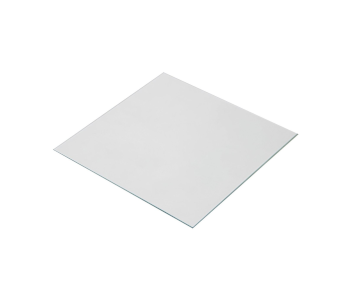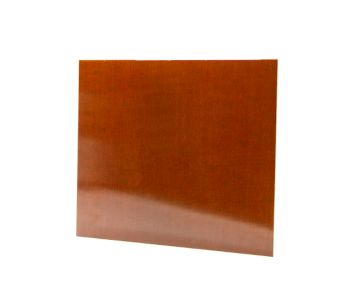A Guide to Choosing the Best 3D Printer Build Plate
It is often said that a perfect base layer is one of the most important components of a perfect 3D print. There are a lot of considerations that go into creating that perfect base layer – the bed temperature, the type of adhesive used, and the z-offset of the nozzle among others.
However, one of the more important decisions you need to make is which type of print bed or build plate to use. While your 3D printer comes with a default build plate, there are lots of third-party options or replacements out there. Which one should you use?
The importance of a build plate
The build plate of a 3D printer is the flat surface on which the first layer of the molten filament is deposited. It provides stability and dimension accuracy for the entire project even if it only really comes in contact with the first layer. However, this first layer is the foundation for the entire project – it has to be perfect, otherwise, there are lots of things that can go wrong.
The build plate is also the surface to which the first layer of the print adheres. If adhesion is poor, then the layers will tend to shift, and the entire model may collapse or eventually topple over. There are several ways to achieve good adhesion, such as by heating the build plate or applying adhesives like tape or hairspray.
The surface quality of the build plate also influences the outcome of a 3D printing project. If the build plate were perfectly smooth, then this characteristic will also transfer to the bottom of the 3D print. On the other hand, a rough build plate provides a surface that is easier to adhere to. Balancing the importance of adhesion and surface quality is one of the many considerations when choosing between different build plates.
There is simply no way to overstate the importance of a good build plate. If you’re having issues related to warping, bed adhesion, layer shifting, or dimensional accuracy, then making a few tweaks to your build plate setup might just be the solution.
Build plate options
Your 3D printer already comes with a stock build plate by default, typically made with aluminum. The default build plate is still a viable option and is included in our list below. However, the great thing about alternative build plates is that they can just be placed on top of your printer’s default build plate. Switching from one to another is nearly effortless.
As with many 3D printer components, there is not one single superior choice for build plate. By looking at the pros and cons of each option, we should be able to help you determine the best choice for your situation.
Aluminum
The classic aluminum build plate is one that most users are familiar with. Many 3D printers come with an aluminum build plate by default, particularly because of how well it takes up heat. For heated beds, aluminum may be beneficial because of how quickly the material heats up. However, it can also create small “hot spots” in areas of the print bed that are closed to the heating elements.
An aluminum build plate can withstand quite a bit of abuse. This comes in handy when you have a hard time scraping off a finished print from the build plate. Yes, aluminum can still be scratched, but you likely won’t damage it so bad that you will need to have it replaced right away. This resistance to wear and tear, coupled with the low cost of aluminum build plates, makes aluminum one of the more cost-effective options.
| PROS | CONS |
|---|---|
| Robust and long-lasting | Prone to thermal expansion |
| Heats up quickly | May create localized hot spots |
| Inexpensive |
Glass

Glass is probably the most popular build plate used in the 3D printing community. To use a glass build plate, simply have a piece of borosilicate glass cut to the size of your 3D printer’s print bed. This can then be attached by clips to your 3D printer’s original build plate. It’s simple, elegant, and inexpensive.
Glass offers a lot of unique advantages. It does not expand when heated, eliminating any tendency of the build plate to warp and create dimensional inaccuracies. The perfectly smooth surface of a glass build plate also means that the bottom surfaces of your finished 3D prints will be similarly smooth.
A glass build plate is an excellent medium for the application of adhesives. If your build plate ends up with residual adhesive, just take off the piece of glass and clean it with soap and warm water. With proper care, a glass build plate can last a few years without needing to be replaced.
For all its merits, glass is still not a perfect build plate material. If you struggle with the removal of finished prints, you might end up scratching a glass build plate easily. There is also the matter of glass being quite fragile, particularly if you get into an accident while cleaning or handling it.
| PROS | CONS |
|---|---|
| Smooth surface | Prone to getting scratched |
| Creates even heat distribution | Fragile |
| Easy to clean | |
| Does not warp | |
| Inexpensive |
BuildTak FlexPlate

The BuildTak FlexPlate is technically closer to an adhesive than a build plate. This standalone piece of flexible material is designed to attach to an existing build plate using a system of magnets. This is one of the more unique traits of BuildTak and may be advantageous if you have to maintain a quick 3D printing workflow for high-volume orders.
The BuildTak attaches to a build plate, providing a surface that provides much better bed adhesion. The surface of the BuildTak is not smooth, but rather has a texture that is specifically designed to help filament stick better. With a BuildTak, you will no longer need to use glue, hairspray, or tape.
BuildTak can be used on either glass or metal build plates and can withstand constant exposure to heated beds. When a print is done, the BuildTak can be removed and bent to facilitate print removal. This is a foolproof process that vastly simplifies this crucial step in 3D printing.
A single BuildTak can be used several times if handled with care. However, its surface can also be easily scratched by spatulas and other metal tools. This is problematic because BuildTak can stick a little too well in some circumstances. Replacing BuildTak surfaces frequently can quickly get very expensive.
| PROS | CONS |
|---|---|
| Superior bed adhesion | Expensive |
| Can be removed from the print bed | Prone to getting scratched |
| Can be used with either glass or aluminum | Can stick a little too well |
PEI Sheet

Polyether imide (PEI) is a material that is also used in 3D printing, although only sparingly. As a build plate material, PEI sheets provide superior bed adhesion even for challenging filaments. A single PEI sheet can replace all the glue and tapes that you probably have stocked in your workshop.
There are two types of PEI sheets that you can use for your build plate. The cheaper version is simply a sheet of PEI with a layer of adhesive at the bottom. The idea is to stick this sheet on top of a glass build plate for a semi-permanent setup. You can save a few dollars with this option but applying the PEI sheet perfectly can be a bit tricky.
There is also a version of PEI sheet that comes on a flexible steel platform. This sticks on a magnetic bottom sheet that is also stuck to your existing build plate with adhesive. This effectively makes the PEI sheet removable and changeable. Should your print get stuck, you can flex the steel plate gently to prod it loose.
Users swear by the adhesive properties of PEI, even when printing with ABS. However, PEI notoriously works poorly when printing with Nylon filament. If you have a PEI sheet and Nylon filament, maybe don’t throw out your glue or tape just yet.
| PROS | CONS |
|---|---|
| Superior bed adhesion | Tricky to apply |
| Can be used with either glass or aluminum | Does not work well with Nylon |
| Can be sanded smooth |
Polypropylene

A polypropylene (PP) sheet is considered by many to be a cheaper and lighter alternative to a glass build plate. It can be clipped right onto the existing build plate of your 3D printer, providing a more reliably adhesive surface.
PP sheets have many of the same characteristics as glass. It is slow to heat up, allowing for a more even temperature distribution for heated beds. It also has a smooth surface that creates a better surface finish on improved prints. If you print with PP filament – one of the most difficult filaments to print with – then a PP sheet is your best bet for good bed adhesion.
Unfortunately, bed adhesion can be a hit or miss when using a PP sheet. Some users have reported having problems even when printing with specific PLA brands. If you’re having these problems, you might have to apply a layer of glue on the PP sheet before printing. The PP sheet also isn’t as easy to clean as glass, and you will likely have to sand it smooth periodically to refresh its surface.
| PROS | CONS |
|---|---|
| Works well with PP filament | Not as adhesive as other options |
| Lightweight and durable | Difficult to clean |
| Smooth surface |
Garolite

Garolite is another specialty build plate that is probably the least popular of the choices on this list. It is primarily known as the build plate of choice for printing with Nylon – a material that most other build plates have trouble with. Garolite is also useful for printing with other common filaments including PETG, ABS, and TPU.
In terms of adhesion, Garolite has to be at the top of the list of build plate options. Plastic sticks so well to Garolite that you might even be able to print with Nylon without a heated bed. If the Garolite sheet gets scratched or gets too dirty, you can easily refresh the surface by sanding it with 200-grit sandpaper.
The biggest drawback of Garolite is that it is easily the most expensive entry on this list. There also are not many retailers that carry Garolite sheets for 3D printing, on account of it being not as common as other build plate options.
| PROS | CONS |
|---|---|
| Works exceptionally well with Nylon | Expensive |
| Provides very strong adhesion | Hard to find |
Final thoughts
Your choice of build plate plays an integral role in your 3D printing experience and in the quality of your finished product. If you’ve never tried playing around with different build plates before, then it’s worth the time to experiment with them. This will help you understand the essence of bed adhesion and how materials interact with each other.
The great thing about different build plates is that you can usually just swap one for another. Your glass build plate isn’t working? Then just lay a BuildTak or PEI sheet over it to improve bed adhesion. Having options is always a relief when you encounter 3D printing issues.





